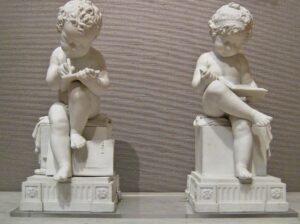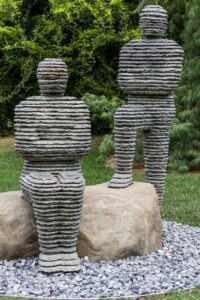Direct carving is a transformative technique in sculpture, where artists engage directly with their materials, creating pieces that are raw and powerful.
It’s a method that bypasses preliminary models or maquettes, connecting the artist’s vision straight to the medium.
We’ll explore the history and significance of this approach, and why it’s revered by sculptors for its authenticity and immediacy.
Stay tuned as we jump into the world of direct carving, a practice that brings the artist’s touch closer to the final work of art.
History Of Direct Carving In Art
Direct carving has roots that extend deep into art history.
Often associated with primitivism, this technique gained popularity among modernist artists in the late-19th and early-20th centuries.
Henri Gaudier-Brzeska and Constantin Brâncuși were pivotal figures, shifting the focus from academic traditions to a more authentic expression of the material.
In the early stages, these avant-garde artists drew inspiration from African, Oceanic, and Native American artforms.
These cultures had a longstanding history of carving directly into wood, bone, and stone, emphasizing the materials’ inherent qualities and spiritual resonance.
- Among notable works from this period is Brâncuși’s The Kiss which embodies the essential qualities of direct carving,
- Gaudier-Brzeska’s Hieratic Head of Ezra Pound exemplifies the dynamic energy achieved through this technique.
The approach wasn’t just about aesthetics; it was a radical statement against the industrialization of the era.
Artists rejected the mechanization of art production, embracing handcrafting as a form of individual expression and resistance.
During the 20th century, direct carving became intertwined with social and political movements.
Sculptors like Jacob Epstein and Barbara Hepworth embraced the method, celebrating the raw and direct experiences it provided, both in form and content.
Their works often reflected the tumultuous times they were created in.
- Epstein’s Rock Drill stands as a critical commentary on technology and warfare,
- Hepworth’s Single Form speaks to human experience and connection.
For us filmmakers, the same principles can apply when choosing practical effects over CGI or preferring location shoots to studio settings.
Like sculptors with their materials, filmmakers create authenticity by engaging directly with the physical aspects of their medium.
Characteristics Of Direct Carving
When we jump into the characteristics of direct carving, we find a rich tapestry of artistic Try rooted in direct engagement with the materials.
In this approach, artists like Constantin Brancusi or Henry Moore favored the tactile relationship with stone or wood over the indirect methods of casting or modeling.
Artists practicing direct carving share common traits:
- Intuition – Artists rely heavily on their intuitive sense of the material, allowing the medium’s natural properties to guide the final form.
- Immediacy – There’s a directness to the artist’s interaction with the medium, often leading to a more spontaneous and organic creation.
- Authenticity – The essence of the material remains visible, and the artist’s hand is evident in each mark made.
The method necessitates a profound understanding of the medium.
From the coarseness of granite to the delicate grain of alabaster, artists tailor their technique to the medium’s unique demands.
We see this in the dynamism of Barbara Hepworth’s forms or the raw power of Michelangelo’s Prisoners series – pieces left intentionally unfinished, yet speaking volumes through their textured surfaces.
Besides, direct carving emphasizes the material’s innate qualities.
The artist respects the nuances of the medium, be it wood’s warmth or marble’s cool austerity.
In films, this appreciation for authenticity is paralleled in the use of practical effects.
Some directors, like Christopher Nolan with his preference for in-camera effects, mirror the sculptor’s desire to harness the pure qualities of their tools.
The process is not without its inherent challenges.
The irreversible nature of removing material requires foresight and precision – a strike too hard, and the integrity of the work may be compromised, demanding a confidence that resonates with the decisive cuts of an editor in film.
Direct carving continues to be a powerful means for artists to express their unmediated vision.
As you jump into the artworks created through this method, the character of both the artist and the medium is unveiled, each piece a testament to the enduring alliance between creator and material.
Materials Used In Direct Carving
When we jump into the art of direct carving, understanding the types of materials sculptors favor is essential.
Artists select mediums based on their texture, malleability, and how they react to different tools.
For sculptors, each material presents unique challenges and possibilities.
Some commonly used materials in direct carving include:
- Stone – with varieties such as marble, alabaster, and granite offering differing levels of hardness and color – Wood – appreciated for its warmth and grain; hardwoods like oak and mahogany are popular for their durability – Ice – used for its translucent quality and temporal nature, emphasizing the immediacy of the art form.
These materials are not just passive recipients of an artist’s vision; they are active participants in the creative process.
Stone begs for the chisel’s strike, wood reveals its history through the grain, and ice demands swift work before it succumbs to the warmth of the air.
Sculptors must possess a deep understanding of their chosen material to anticipate how it will respond.
The characteristics of stone can dictate the strength of the strikes and the delicacy of the detailing.
The direction of wood’s grain influences carving techniques to avoid unwanted splitting.
With ice, temperature plays a pivotal role, as artists must work within the constraints of the material’s melting point.
The relationship between artist and medium in direct carving is profoundly intimate.
The medium’s response to each action guides the sculptor’s hand, creating a dialogue in which the final piece is born.
From the resilient defiance of granite to the supple give of pine, each material informs the creation process with its own voice.
Techniques And Process In Direct Carving
Direct carving is a practice where the true character of materials shines through.

It’s a hands-on, engaging process, and artists often speak of the dialog that unfolds between themselves and the material.
But what are these techniques, and how do they manifest from conception to completion?

The process starts with securing the raw material, which in itself is a thoughtful choice.
An understanding of the material properties is critical as it determines the tools and techniques suitable for carving.
To skillfully transform a block of stone into a fluid form, carving tools like chisels, hammers, and points are meticulously employed.
Sculpting Dynamics involve iterative cycles of shaping and tactical evaluation.
Artists remove material in a subtractive process, intuiting the path of least resistance.
In stone, the method creates a rhythm almost musical – the sound of metal on stone rings as a testament to progressing work.
With wood, the sculptor deals with the alignment of grains, knots, and the propensity of the wood to split, demanding diverse tactics.
- Exploration of form – Textural evolution – Detail refinement.
In the world of metal or ice, artists must contend with the ephemeral nature of their sculptures.
Metals are often heated to enable malleability before hammering and etching define the finer details.
With ice, the urgency is pronounced; the sculptor must race against melting as they chisel elaborate forms from the icy canvas.
Today’s technological advancements have also touched direct carving.
While traditional methods prevail, some sculptors integrate power tools to expedite certain tasks.
Yet, the essence of tool-to-hand-to-material remains the heart of the technique.
Every chip away reveals more of the envisioned piece, a dialogue in physical form.
We witness a notable combination of power and grace, as the artist must forcefully remove material while also being gentle enough to not damage the evolving piece.
Direct carving isn’t merely a tactile experience but a profound expression of artistic vision manifesting through unwavering physical labor and intrinsic understanding of the medium.
Significance And Impact Of Direct Carving In Sculpture
Direct carving has profoundly influenced various art movements and sculptors across eras.
Pioneered by artists like Constantin Brancusi and Henry Moore, this process established itself as a reaction against the more academic modeling practices.
We observe that through direct carving, artists attain an unmediated rapport with their material – whether it’s stone, wood, or metal – leading to innovative forms and expressions.
The impact of direct carving in sculpture is evident in the originality and authenticity it brings to artworks.
Every stroke and chip carries the individual mark of the sculptor, allowing personal expression to weave into the medium’s natural characteristics.
In the works of Barbara Hepworth, for example, the essence of direct carving can be seen in the smooth contours and compelling voids, bringing forth an intimate engagement between the viewer, the sculpture, and space.

- Direct carving connects an artist’s vision with tangible form,
- The technique emphasizes the true nature of materials,
- It offers a unique interpretation of the subject, influenced by the medium itself.
By focusing intensely on the physical act of carving, sculptors practicing direct carving can also elicit a deeper understanding of three-dimensional space.
They’re not merely shaping the medium, but they’re also sculpting the invisible space around it.
The method became instrumental in the evolution of abstract sculpture, offering a different perspective from traditional figurative works.
This sculptural approach has transcended beyond the fine arts and into the realms of filmmaking and digital marketing.
In set design and special effects, the principles of direct carving empower creators to craft intricate and impactful visual elements that resonate with audiences.
Cinematic works often Use sculptures that adhere to the aesthetics of direct carving, highlighting the interplay of shadow, light, and form.
- Direct carving principles enhance visual storytelling,
- Set designs benefit from the texture and depth created through direct carving.
Similarly, in the digital space, the philosophy of direct carving inspires designers to incorporate tactile qualities in virtual interfaces, enriching the user experience.
The technique’s influence is widespread, proving its endurance and adaptability across various creative disciplines.
What Is Direct Carving In Art – Wrap Up
We’ve explored the essence and influence of direct carving, a technique that’s shaped the world of sculpture with its raw and intuitive approach.
It’s clear that this method is more than just a way of creating art—it’s a dialogue between artist and medium that fosters authenticity in every piece.
Direct carving’s legacy is evident in the unique forms it has inspired and its expansion into other creative fields.
As we appreciate the tactile beauty of these sculptures, let’s remember the skill and vision that direct carving demands from the artist, a testament to the enduring power of this artistic process.
Frequently Asked Questions
What Is Direct Carving In Sculpture?
Direct carving is a subtractive sculpting process where the artist works directly on the material, intuitively shaping it by removing pieces, without intermediary models or molds.
Why Is Securing The Raw Material Significant In Direct Carving?
Securing the right raw material is crucial as it determines the appropriate tools and carving techniques, impacting the final artistic expression.
Does Direct Carving Involve Any Power Tools?
While some sculptors use power tools, the essence of direct carving lies in the tactile connection between the tool, the artist’s hand, and the material.
How Does Direct Carving Influence The Artistic Expression?
Direct carving allows for a personal and unmediated relationship between the artist and the material, leading to original, authentic artworks with each mark reflecting the individual sculptor.
In What Ways Has Direct Carving Impacted Art Movements?
Direct carving has influenced various art movements by encouraging unmediated interaction with sculpting materials and pioneering innovative forms and artistic expressions.
Can Principles Of Direct Carving Be Applied Outside Of Sculpting?
Yes, the principles of direct carving extend beyond sculpting to disciplines like filmmaking, set design, and digital interfaces, enhancing narrative visualization and user experiences.


